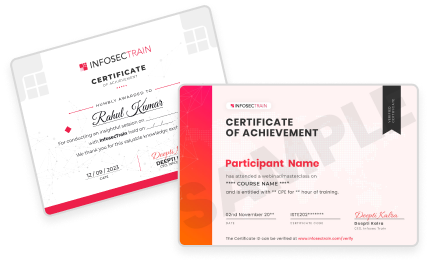Program Highlights
CISSP is the most renowned certification in the information security domain. Our latest CISSP training program aims to equip participants with in-demand technical and administrative competence to design, architect, and manage an organization’s security posture by applying internationally accepted information security standards.
The CISSP® was the first credential in information security to meet the stringent requirements of ISO/IEC Standard 17024. It is looked upon as an objective measure of excellence and a highly reputed standard of achievement.
48-Hour Instructor-Led Training
Full 8 Domain Exam Practice
Online Test Simulations
Learn Better with Flash Cards & Mind Maps
98% Exam Pass Rate
Highly Experienced Instructors
Telegram Group for Exam Support
Post Training Support Till Exam
Access to Recorded Sessions
Learning Schedule
- upcoming classes
- corporate training
- 1 on 1 training
| 17 Aug - 27 Sep | Online | Weekend | 19:00 - 23:00 IST | BATCH OPEN | |
| 23 Aug - 28 Sep | Online | Weekend | 09:00 - 13:00 IST | BATCH OPEN | |
| 06 Sep - 12 Oct | Online | Weekend | 09:00 - 13:00 IST | BATCH FULL | |
| 08 Sep - 13 Oct | Online | Weekday | 08:00 - 10:00 IST | BATCH OPEN | |
| 27 Sep - 09 Nov | Online | Weekend | 09:00 - 13:00 IST | BATCH OPEN | |
| 29 Sep - 04 Oct | Classroom Bengaluru |
Weekend-Weekday | 09:00 - 17:00 IST | BATCH OPEN | |
| 06 Oct - 27 Oct | Online | Weekday | 07:00 - 12:00 IST | BATCH FULL | |
| 11 Oct - 16 Nov | Online | Weekend | 19:00 - 23:00 IST | BATCH OPEN |
Why Choose Our Corporate Training Solution
- Upskill your team on the latest tech
- Highly customized solutions
- Free Training Needs Analysis
- Skill-specific training delivery
- Secure your organizations inside-out
Why Choose 1-on-1 Training
- Get personalized attention
- Customized content
- Learn at your dedicated hour
- Instant clarification of doubt
- Guaranteed to run
Can't Find a Suitable Schedule? Talk to Our Training Advisor
Domain 1: Security and Risk Management
- 1.1 – Understand, adhere to, and promote professional ethics
- ISC2 Code of Professional Ethics
- Organizational code of ethics
- 1.2 – Understand and apply security concepts
- Confidentiality, integrity, and availability, authenticity, and nonrepudiation (5 Pillars of Information Security)
- 1.3 – Evaluate and apply security governance principles
- Alignment of the security function to business strategy, goals, mission, and objectives
- Organizational processes (e.g., acquisitions, divestitures, governance committees)
- Organizational roles and responsibilities
- Security control frameworks (e.g., International Organization for Standardization (ISO), National Institute of Standards and Technology (NIST), Control Objectives for Information and Related Technology (COBIT), Sherwood Applied Business Security Architecture (SABSA), Payment Card Industry (PCI), Federal Risk and Authorization Management Program (FedRAMP))
- Due care/due diligence
- 1.4 – Understand legal, regulatory, and compliance issues that pertain to information security in a holistic context
- Cybercrimes and data breaches
- Licensing and Intellectual Property requirements
- Import/export controls
- Transborder data flow
- Issues related to privacy (e.g., General Data Protection Regulation (GDPR), California Consumer Privacy Act, Personal Information Protection Law, Protection of Personal Information Act)
- Contractual, legal, industry standards, and regulatory requirements
- 1.5 – Understand requirements for investigation types (i.e., administrative, criminal, civil, regulatory, industry standards)
- 1.6 – Develop, document, and implement security policy, standards, procedures, and guidelines
- 1.7 – Identify, analyze, assess, prioritize, and implement Business Continuity (BC) requirements
- Business impact analysis (BIA)
- External dependencies
- 1.8 – Contribute to and enforce personnel security policies and procedures
- Candidate screening and hiring
- Employment agreements and policy driven requirements
- Onboarding, transfers, and termination processes
- Vendor, consultant, and contractor agreements and controls
- 1.9 – Understand and apply risk management concepts
- Threat and vulnerability identification
- Risk analysis, assessment, and scope
- Risk response and treatment (e.g., cybersecurity insurance)
- Applicable types of controls (e.g., preventive, detection, corrective)
- Control assessments (e.g., security and privacy)
- Continuous monitoring and measurement
- Reporting (e.g., internal, external)
- Continuous improvement (e.g., risk maturity modeling)
- Risk frameworks (e.g., International Organization for Standardization (ISO), National Institute of Standards and Technology (NIST), Control Objectives for Information and Related Technology (COBIT), Sherwood Applied Business Security Architecture (SABSA), Payment Card Industry (PCI))
- 1.10 – Understand and apply threat modeling concepts and methodologies
- 1.11 – Apply Supply Chain Risk Management (SCRM) concepts
- Risks associated with the acquisition of products and services from suppliers and providers (e.g., product tampering, counterfeits, implants)
- Risk mitigations (e.g., third-party assessment and monitoring, minimum security requirements, service level requirements, silicon root of trust, physically unclonable function, software bill of materials)
- 1.12 – Establish and maintain a security awareness, education, and training program
- Methods and techniques to increase awareness and training (e.g., social engineering, phishing, security champions, gamification)
- Periodic content reviews to include emerging technologies and trends (e.g., cryptocurrency, artificial intelligence (AI), blockchain)
- Program effectiveness evaluation
Domain 2: Asset Security
- 2.1 – Identify and classify information and assets
- Data classification
- Asset Classification
- 2.2 – Establish information and asset handling requirements
- 2.3 – Provision information and assets securely
- Information and asset ownership
- Asset inventory (e.g., tangible, intangible)
- Asset management
- 2.4 – Manage data lifecycle
- Data roles (i.e., owners, controllers, custodians, processors, users/subjects)
- Data collection
- Data location
- Data maintenance
- Data retention
- Data remanence
- Data destruction
- 2.5 – Ensure appropriate asset retention (e.g., End of Life (EOL), End of Support)
- 2.6 – Determine data security controls and compliance requirements
- Data states (e.g., in use, in transit, at rest)
- Scoping and tailoring
- Standards selection
- Data protection methods (e.g., Digital Rights Management (DRM), Data Loss Prevention (DLP), Cloud Access Security Broker (CASB))
Domain 3: Security Architecture and Engineering
- 3.1 – Research, implement and manage engineering processes using secure design principles
- Threat modeling
- Least privilege
- Defense in depth
- Secure defaults
- Fail securely
- Segregation of Duties (SoD)
- Keep it simple and small
- Zero trust or trust but verify
- Privacy by design
- Shared responsibility
- Secure access service edge
- 3.2 – Understand the fundamental concepts of security models (e.g., Biba, Star Model, Bell-LaPadula)
- 3.3 – Select controls based upon systems security requirements
- 3.4 – Understand security capabilities of Information Systems (IS) (e.g., memory protection, Trusted Platform Module (TPM), encryption/decryption)
- 3.5 – Assess and mitigate the vulnerabilities of security architectures, designs, and solution elements
- Client-based systems
- Server-based systems
- Database systems
- Cryptographic systems
- Industrial Control Systems (ICS)
- Cloud-based systems (e.g., Software as a Service (SaaS), Infrastructure as a Service (IaaS), Platform as a Service (PaaS))
- Distributed systems
- Internet of Things (IoT)
- Microservices (e.g., application programming interface (API))
- Containerization
- Serverless
- Embedded systems
- High-Performance Computing systems
- Edge computing systems
- Virtualized systems
- 3.6 – Select and determine cryptographic solutions
- Cryptographic life cycle (e.g., keys, algorithm selection)
- Cryptographic methods (e.g., symmetric, asymmetric, elliptic curves, quantum)
- Public key infrastructure (PKI) (e.g., quantum key distribution)
- 3.7 – Understand methods of cryptanalytic attacks
- Brute force
- Ciphertext only
- Known plaintext
- Frequency analysis
- Chosen ciphertext
- Implementation attacks
- Side-channel
- Fault injection
- Timing
- Man-in-the-Middle (MITM)
- Pass the hash
- Kerberos exploitation
- Ransomware
- 3.8 – Apply security principles to site and facility design
- 3.9 – Design site and facility security controls
- Wiring closets/intermediate distribution facilities
- Server rooms/data centers
- Media storage facilities
- Evidence storage
- Restricted and work area security
- Utilities and Heating, Ventilation, and Air Conditioning (HVAC)
- Environmental issues (e.g., natural disasters, man-made)
- Fire prevention, detection, and suppression
- Power (e.g., redundant, backup)
- 3.10 – Manage the information system lifecycle
- Stakeholders needs and requirements
- Requirements analysis
- Architectural design
- Development /implementation
- Integration
- Verification and validation
- Transition/deployment
- Operations and maintenance/sustainment
- Retirement/disposal
Domain 4: Communication and Network Security
- 4.1 – Apply secure design principles in network architectures
- Open System Interconnection (OSI) and Transmission Control Protocol/Internet Protocol (TCP/IP) models
- Internet Protocol (IP) version 4 and 6 (IPv6) (e.g., unicast, broadcast, multicast, anycast)
- Secure protocols (e.g., Internet Protocol Security (IPSec), Secure Shell (SSH), Secure Sockets Layer (SSL)/ Transport Layer Security (TLS))
- Implications of multilayer protocols
- Converged protocols (e.g., Internet Small Computer Systems Interface (iSCSI), Voice over Internet Protocol (VoIP), InfiniBand over Ethernet, Compute Express Link)
- Transport architecture (e.g., topology, data/control/management plane, cut-through/store-and-forward)
- Performance metrics (e.g., bandwidth, latency, jitter, throughput, signal-to-noise ratio)
- Traffic flows (e.g., north-south, east-west)
- Physical segmentation (e.g., in-band, out-of-band, air-gapped)
- Logical segmentation (e.g., virtual local area networks (VLANs), virtual private networks (VPNs), virtual routing and forwarding, virtual domain)
- Micro-segmentation (e.g., network overlays/encapsulation; distributed firewalls, routers, intrusion detection system (IDS)/intrusion prevention system (IPS), zero trust)
- Edge networks (e.g., ingress/egress, peering)
- Wireless networks (e.g., Bluetooth, Wi-Fi, Zigbee, satellite)
- Cellular/mobile networks (e.g., 4G, 5G)
- Content distribution networks (CDN)
- Software defined networks (SDN), (e.g., application programming interface (API), Software-Defined Wide- Area Network, network functions virtualization)
- Virtual Private Cloud (VPC)
- Monitoring and management (e.g., network observability, traffic flow/shaping, capacity management, fault detection and handling)
- 4.2 – Secure network components
- Operation of infrastructure (e.g., redundant power, warranty, support)
- Transmission media (e.g., physical security of media, signal propagation quality)
- Network Access Control (NAC) systems (e.g., physical, and virtual solutions)
- Endpoint security (e.g., host-based)
- 4.3 – Implement secure communication channels according to design
- Voice, video, and collaboration (e.g., conferencing, Zoom rooms)
- Remote access (e.g., network administrative functions)
- Data communications (e.g., backhaul networks, satellite)
- Third-party connectivity (e.g., telecom providers, hardware support)
Domain 5: Identity and Access Management (IAM)
- 5.1 – Control physical and logical access to assets
- Information
- Systems
- Devices
- Facilities
- Applications
- Services
- 5.2 – Design identification and authentication strategy (e.g., people, devices, and services)
- Groups and Roles
- Authentication, Authorization and Accounting (AAA) (e.g., multi-factor authentication (MFA), password-less authentication)
- Session management
- Registration, proofing, and establishment of identity
- Federated Identity Management (FIM)
- Credential management systems (e.g., Password vault)
- Single sign-on (SSO)
- Just-In-Time
- 5.3 – Federated identity with a third-party service
- On-premise
- Cloud
- Hybrid
- 5.4 – Implement and manage authorization mechanisms
- Role-based access control (RBAC)
- Rule based access control
- Mandatory access control (MAC)
- Discretionary access control (DAC)
- Attribute-based access control (ABAC)
- Risk based access control
- Access policy enforcement (e.g., policy decision point, policy enforcement point)
- 5.5 – Manage the identity and access provisioning lifecycle
- Account access review (e.g., user, system, service)
- Provisioning and deprovisioning (e.g., on /off boarding and transfers)
- Role definition and transition (e.g., people assigned to new roles)
- Privilege escalation (e.g., use of sudo, auditing its use)
- Service accounts management
- 5.6 – Implement authentication systems
Domain 6: Security Assessment and Testing
- 6.1 – Design and validate assessment, test, and audit strategies
- Internal (e.g., within organization control)
- External (e.g., outside organization control)
- Third-party (e.g., outside of enterprise control)
- Location (e.g., on-premises, cloud, hybrid)
- 6.2 – Conduct security control testing
- Vulnerability assessment
- Penetration testing (e.g., red, blue, and/or purple team exercises)
- Log reviews
- Synthetic transactions/benchmarks
- Code review and testing
- Misuse case testing
- Coverage analysis
- Interface testing (e.g., user interface, network interface, application programming interface (API))
- Breach attack simulations
- Compliance checks
- 6.3 – Collect security process data (e.g., technical and administrative)
- Account management
- Management review and approval
- Key performance and risk indicators
- Backup verification data
- Training and awareness
- Disaster Recovery (DR) and Business Continuity (BC)
- 6.4 – Analyze test output and generate report
- Remediation
- Exception handling
- Ethical disclosure
- 6.5 – Conduct or facilitate security audits
- Internal (e.g., within organization control)
- External (e.g., outside organization control)
- Third-party (e.g., outside of enterprise control)
- Location (e.g., on-premises, cloud, hybrid)
Domain 7: Security Operations
- 7.1 – Understand and comply with investigations
- Evidence collection and handling
- Reporting and documentation
- Investigative techniques
- Digital forensics tools, tactics, and procedures
- Artifacts (e.g., data, computer, network, mobile device)
- 7.2 – Conduct logging and monitoring activities
- Intrusion detection and prevention (IDPS)
- Security Information and Event Management (SIEM)
- Continuous monitoring and tuning
- Egress monitoring
- Log management
- Threat intelligence (e.g., threat feeds, threat hunting)
- User and Entity Behavior Analytics (UEBA)
- 7.3 – Perform Configuration Management (CM) (e.g., provisioning, baselining, automation)
- 7.4 – Apply foundational security operations concepts
- Need-to-know/least privilege
- Separation of Duties (SoD) and responsibilities
- Privileged account management
- Job rotation
- Service-level agreements (SLA)
- 7.5 – Apply resource protection
- Media management
- Media protection techniques
- Data at rest/data in transit
- 7.6 – Conduct incident management
- Detection
- Response
- Mitigation
- Reporting
- Recovery
- Remediation
- Lessons learned
- 7.7 – Operate and maintain detection and preventative measures
- Firewalls (e.g., next generation, web application, network)
- Intrusion Detection Systems (IDS) and Intrusion Prevention Systems (IPS)
- Whitelisting/blacklisting
- Third-party provided security services
- Sandboxing
- Honeypots/honeynets
- Anti-malware
- Machine learning and Artificial Intelligence (AI) based tools
- 7.8 – Implement and support patch and vulnerability management
- 7.9 – Understand and participate in change management processes
- 7.10 – Implement recovery strategies
- Backup storage strategies (e.g., cloud storage, onsite, offsite)
- Recovery site strategies (e.g., cold vs. hot, resource capacity agreements)
- Multiple processing sites
- System resilience, high availability (HA), Quality of Service (QoS), and fault tolerance
- 7.11 – Implement Disaster Recovery (DR) processes
- Response
- Personnel
- Communications (e.g., methods)
- Assessment
- Restoration
- Training and awareness
- Lessons learned
- 7.12 – Test Disaster Recovery Plans (DRP)
- Read-through/tabletop
- Walkthrough
- Simulation
- Parallel
- Full interruption
- Communications (e.g., stakeholders, test status, regulators)
- 7.13 – Participate in Business Continuity (BC) planning and exercises
- 7.14 – Implement and manage physical security
- Perimeter security controls
- Internal security controls
- 7.15 – Address personnel safety and security concerns
- Travel
- Security training and awareness (e.g., insider threat, social media impacts, two-factor authentication (2FA) fatigue)
- Emergency management
- Duress
Domain 8: Software Development Security
- 8.1 – Understand and integrate security in the Software Development Life Cycle (SDLC)
- Development methodologies (e.g., Agile, Waterfall, DevOps, DevSecOps, Scaled Agile Framework)
- Maturity models (e.g., Capability Maturity Model (CMM), Software Assurance Maturity Model (SAMM))
- Operation and maintenance
- Change management
- Integrated Product Team
- 8.2 – Identify and apply security controls in software development ecosystems
- Programming languages
- Libraries
- Tool sets
- Integrated Development Environment
- Runtime
- Continuous Integration and Continuous Delivery (CI/CD)
- Software configuration management (CM)
- Code repositories
- Application security testing (e.g., static application security testing (SAST), dynamic application security testing (DAST), software composition analysis, Interactive Application Security Test (IAST))
- 8.3 – Assess the effectiveness of software security
- Auditing and logging of changes
- Risk analysis and mitigation
- 8.4 – Assess security impact of acquired software
- Commercial-off-the-shelf (COTS)
- Open source
- Third-party
- Managed services (e.g., enterprise applications)
- Cloud services (e.g., Software as a Service (SaaS), Infrastructure as a Service (IaaS), Platform as a Service (PaaS))
- 8.5 – Define and apply secure coding guidelines and standards
- Security weaknesses and vulnerabilities at the source-code level
- Security of application programming interfaces (API)
- Secure coding practices
- Software-defined security
How We Help You Succeed
Vision
Goal
Skill-Building
Mentoring
Direction
Support
Success

Career Transformation
Information Security experts needed
The average cost of a data breach
Organizations plan to recruit trained staff
Organizations plan to invest in training
Education
Healthcare
Retail
Government
Manufacturing
Finance


Your Trusted Instructors

18+ Years Of Experience
25+ Years of Experience
16+ Years of Experience
10+ Years of Experience
22+ Years Of Experience
17+ Years Of Experience
Words Have Power

InfosecTrain’s CISSP training was excellent! The instructor was highly knowledgeable and patient, explaining complex CISSP concepts in a way that was easy to understand. They effectively clarified doubts and answered all questions during the session, making the learning experience smooth and engaging.

Overall, I am very satisfied with all aspects of the CISSP training by InfosecTrain. The trainer was highly knowledgeable, approachable, and genuinely passionate about helping others. A great learning experience!

The CISSP training by InfoSecTrain was excellent. The instructor demonstrated a deep understanding of the material and answered all questions clearly and thoroughly. Explanations were concise and easy to follow, making complex topics much more digestible. The class was highly engaging, and the quiz questions provided were particularly helpful in reinforcing key concepts and preparing us for the exam. I would highly recommend this course to others.

Thank you, InfosecTrain, for an excellent CISSP training session! The entire class was insightful and engaging, making the learning experience truly enjoyable. Looking forward to applying this knowledge in the cybersecurity domain!

This is an exceptionally well-structured course that helped me tremendously in clearing my doubts. I highly recommend InfosecTrain’s CISSP Training for anyone looking to deepen their understanding of cybersecurity.

InfosecTrain’s CISSP Training simplifies complex concepts, making learning easy and effective. The support provided throughout the training ensures a smooth learning experience. Highly recommended for CISSP aspirants!
Success Speaks Volumes
Get a Sample Certificate

Frequently Asked Questions
What is CISSP certification?
The Certified Information Systems Security Professional (CISSP) certification is a globally recognized credential in the field of information security. It is designed for IT professionals who wish to demonstrate their expertise in designing, implementing, and managing a best-in-class cybersecurity program. The certification is offered by (ISC)², the International Information System Security Certification Consortium.
How can I prepare for the CISSP exam?
Preparing for the CISSP exam can be a comprehensive process. Here's a condensed guide with key pointers to help you get ready for the exam:
- Make a study plan
- Join study groups for collaboration
- Prioritize understanding over memorization
- Regularly practice with mock exams
- Ensure materials are current with the exam outline
- Enroll in structured learning
- Study with the Official (ISC)² CISSP CBK Reference and Study Guide
- Simplify concepts with CISSP For Dummies
- Take Official (ISC)² Practice Tests.
- Use Boson Practice Exams for simulation.
- Read How To Think Like A Manager for the CISSP Exam for strategy.
What are the prerequisites for CISSP certification?
To apply for the CISSP® course certification, you need to:
- Have a minimum of 5 years of cumulative paid full-time work experience in two or more of the 8 domains of the (ISC)² CISSP® Common Body of Knowledge (CBK).
- A one-year experience waiver can be earned with a 4-year college degree, regional equivalent, or additional credential from the (ISC)² approved list.
How many attempts do I have to pass the CISSP exam?
(ISC)² does not limit the number of times you can attempt the CISSP exam, but there are waiting periods between attempts. Typically, you must wait 30 days after your first failed attempt and 90 days after subsequent failed attempts, up to a maximum of three times within a 12-month period.
What is the passing score for the CISSP certification exam?
The passing score for the CISSP exam is 700 out of 1000 points.
What are CPEs?
Continuing Professional Education (CPE) credits are required to maintain your CISSP certification. CISSP holders must earn and report a minimum of 40 CPE credits per year and a total of 120 CPE credits over the three-year certification cycle.
Is the CISSP exam difficult to pass?
The CISSP exam is widely recognized for its rigorous assessment of a candidate's understanding across the broad spectrum of information security topics, demanding a deep and comprehensive knowledge of its eight domains. While it poses a significant challenge, dedicated and well-prepared candidates can navigate its complexities successfully with the right approach to training and preparation.
How long is the CISSP certification valid for?
The CISSP certification is valid for three years.
What are the career prospects after CISSP certification?
Earning the CISSP certification can open doors to senior and managerial positions in information security, such as:
- Chief Information Security Officer (CISO)
- Security Manager
- IT Director/Manager
- Security Auditor
- Security Architect
- Security Analyst
Can I take the CISSP exam online or at a testing center?
The CISSP exam is available at authorized Pearson VUE testing centers worldwide. (ISC)² does not offer the CISSP exam in an online format that can be taken remotely.
How long does it take to prepare for the CISSP exam?
Preparation time varies by individual, depending on background, experience, and familiarity with the material.




 1800-843-7890 (India)
1800-843-7890 (India)